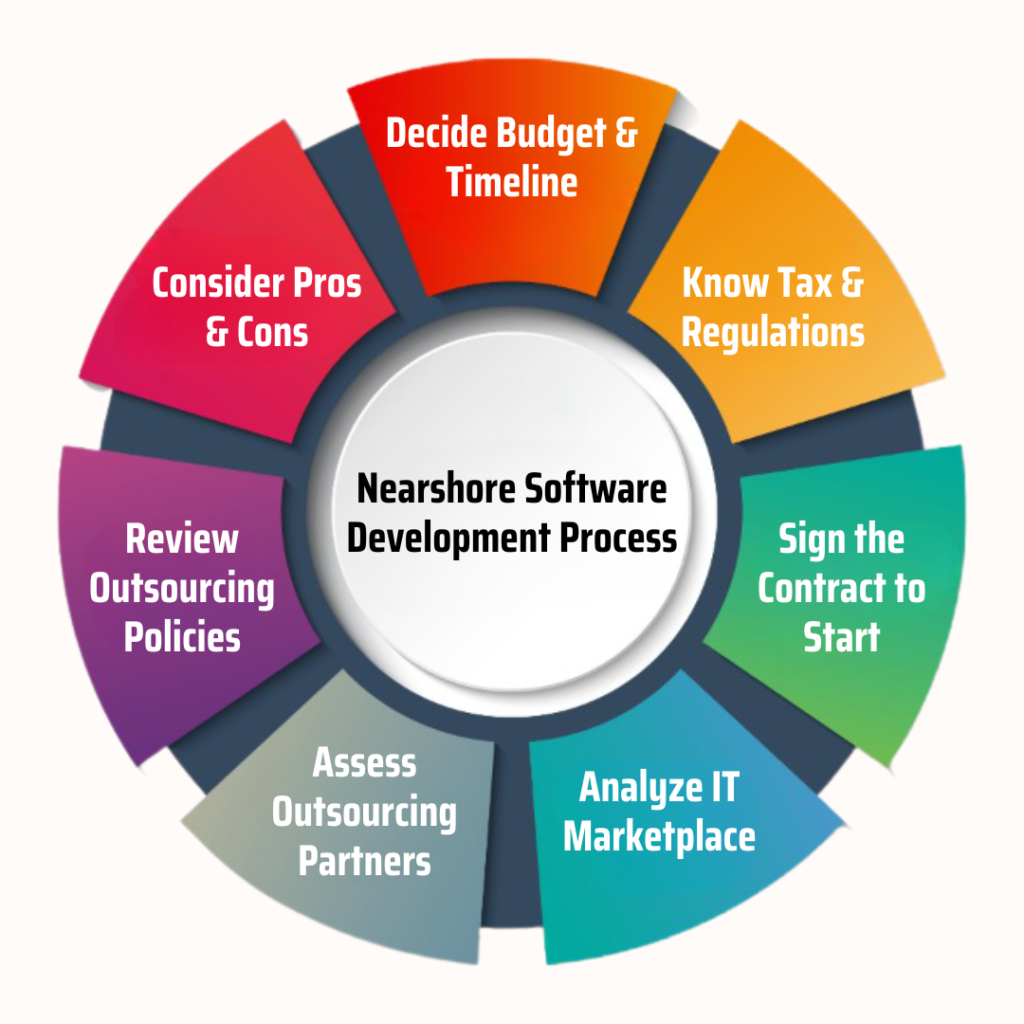Navigating the Nearshore Landscape: A Comprehensive Guide to Finding Your Perfect Software Development Partner
 .
.
Embarking on a software development journey can be both exhilarating and daunting. The promise of innovative solutions and enhanced business processes is alluring, but the complexities of project management, technical expertise, and budget constraints can quickly become overwhelming. This is where nearshore software development companies step in, offering a compelling alternative to traditional outsourcing models.
Nearshoring, as the name suggests, involves partnering with development teams located in geographically proximate regions. This proximity brings a unique set of advantages, including cultural alignment, reduced time zone differences, and easier communication, making it an attractive option for businesses seeking to optimize their software development processes. But with a growing number of nearshore providers vying for your attention, how do you navigate this landscape and find the perfect partner for your specific needs?
This comprehensive guide delves into the intricacies of nearshore software development, providing a roadmap for making informed decisions and finding the ideal partner to bring your software vision to life. We’ll explore the advantages and disadvantages of nearshore development, analyze the key factors to consider when selecting a provider, and equip you with the knowledge to confidently navigate this dynamic industry. By the end of this guide, you’ll have a clear understanding of the nearshore landscape and be empowered to choose the right partner to propel your software development journey forward.
The Rise of Nearshore Software Development
 .
.
The global software development landscape has undergone a dramatic transformation in recent years, with nearshore development emerging as a prominent force. Driven by the increasing demand for high-quality, cost-effective software solutions, businesses are increasingly turning to nearshore providers to leverage their expertise and talent pool. This shift is fueled by a confluence of factors, including:
- The growing availability of skilled software developers in nearshore regions: Latin America, Eastern Europe, and North Africa have witnessed a surge in talent, with universities and training programs churning out a steady stream of skilled professionals. This readily available talent pool provides nearshore providers with a competitive edge, enabling them to offer competitive pricing and high-quality services.
- The increasing adoption of agile methodologies: Nearshore companies are adept at implementing agile development frameworks, fostering collaboration and rapid iteration, which aligns perfectly with the evolving demands of modern software development.
- The growing focus on cost optimization: Nearshore development offers a compelling cost advantage compared to onshore development, without compromising on quality or communication. This cost-effectiveness makes it an attractive option for businesses seeking to maximize their ROI.
.
However, the rise of nearshore development has also brought its share of challenges. The increasing competition among providers has led to a need for greater transparency, accountability, and a focus on building long-term partnerships. As a business owner, it’s crucial to understand the nuances of nearshore development and navigate this landscape with a discerning eye.
Understanding the Advantages of Nearshore Software Development
Nearshore software development offers a unique blend of benefits, positioning it as a compelling alternative to traditional outsourcing models. Here’s a breakdown of the key advantages that make nearshore development a viable option for businesses of all sizes:
- Cost-Effectiveness: Nearshore development companies often offer competitive pricing compared to onshore development, making it an attractive option for businesses seeking to optimize their software development budget. This cost-effectiveness is driven by the lower cost of living and labor in nearshore regions.
- Improved Communication and Collaboration: The close proximity of nearshore development teams reduces time zone differences and facilitates seamless communication. This proximity fosters a collaborative environment, enabling teams to work together effectively and resolve issues promptly.
- Cultural Alignment: Nearshore companies often operate in regions with similar cultural values and business practices as their clients. This cultural alignment can facilitate smoother communication, collaboration, and understanding, leading to more successful project outcomes.
- Access to Specialized Talent: Nearshore regions boast a diverse pool of skilled software developers with specialized expertise in various technologies and domains. This access to specialized talent allows businesses to find the right team for their specific needs, ensuring the successful execution of complex projects.
- Faster Time-to-Market: The efficient communication and collaboration fostered by nearshore development can accelerate the software development lifecycle, enabling businesses to bring their products and services to market faster. This reduced time-to-market can provide a competitive advantage, allowing businesses to capitalize on market opportunities quickly.
 .
.
 .
.
While nearshore development offers numerous advantages, it’s essential to acknowledge the potential drawbacks to make an informed decision.
Navigating the Challenges of Nearshore Software Development
Despite its numerous benefits, nearshore software development comes with its own set of challenges that businesses must be aware of. Here’s a breakdown of the potential drawbacks that can impact the success of nearshore development projects:
- Language Barriers: While many nearshore development teams operate in English-speaking regions, language barriers can still pose a challenge, particularly when dealing with complex technical concepts or nuanced communication. To mitigate this, businesses should ensure that their chosen nearshore provider has a strong command of English and a proven track record of successful communication with international clients.
- Cultural Differences: Despite cultural alignment, subtle differences in communication styles, work ethics, and decision-making processes can still arise. Businesses should be prepared to adapt their communication strategies and foster a culture of understanding and respect to bridge these cultural gaps.
- Security Concerns: Businesses must be vigilant about data security when working with nearshore providers. Choosing a provider with robust security protocols, data encryption practices, and a commitment to data privacy is crucial to ensure the protection of sensitive information.
- Time Zone Differences: While time zone differences are generally smaller in nearshore development compared to offshore, they can still impact communication and collaboration. Businesses should consider these differences when planning meetings and scheduling work hours to ensure effective communication and minimize delays.
- Project Management Challenges: Managing nearshore development projects requires a different approach than managing onshore teams. Businesses need to establish clear communication channels, define project scope and deliverables, and implement robust project management methodologies to ensure successful execution.
 .
.
Navigating these challenges requires a proactive approach and a thorough understanding of the nearshore landscape. By carefully selecting a nearshore provider and establishing clear communication and collaboration protocols, businesses can mitigate these challenges and maximize the benefits of nearshore development.
Key Factors to Consider When Choosing a Nearshore Software Development Company
Selecting the right nearshore software development company is paramount to the success of your project. Here are some key factors to consider when evaluating potential partners:
- Technical Expertise: The chosen provider should possess the necessary technical expertise and experience in the technologies and domains relevant to your project. Look for a team with a proven track record of successful projects in your industry or with similar technical requirements.
- Communication and Collaboration: Effective communication and collaboration are crucial for successful nearshore development. Choose a provider with strong communication skills, a willingness to work collaboratively, and a commitment to transparency.
- Cultural Alignment: Consider the cultural alignment between your business and the nearshore provider. A provider with similar values and work ethics can facilitate smoother communication, collaboration, and understanding.
- Project Management Capabilities: The nearshore provider should have robust project management processes in place to ensure the timely and efficient execution of your project. Look for a provider with experience in agile methodologies and a proven track record of delivering projects on time and within budget.
- Security and Data Privacy: Data security and privacy are paramount when working with nearshore providers. Choose a provider with robust security protocols, data encryption practices, and a commitment to data privacy.
- Cost and Pricing Transparency: Ensure that the nearshore provider provides transparent pricing and clearly outlines the scope of services included in their fees. Avoid providers with hidden costs or unclear pricing structures.
- Reputation and Client Testimonials: Research the reputation of the nearshore provider and read client testimonials to get a sense of their track record and client satisfaction. Look for a provider with a positive reputation and a history of delivering high-quality software solutions.
By carefully evaluating these factors, businesses can identify nearshore providers that align with their specific needs and expectations. This due diligence will help you choose a partner that can deliver high-quality software solutions, meet your project deadlines, and contribute to your business success.
Popular Nearshore Development Locations
The nearshore development landscape is diverse, with several regions emerging as hubs for software development talent. Here’s a closer look at some of the most popular nearshore development locations:
- Latin America: Latin America has become a major hub for nearshore development, with countries like Mexico, Colombia, and Argentina boasting a strong pool of skilled software developers. These countries offer a combination of cost-effectiveness, cultural alignment, and a growing tech ecosystem.
- Eastern Europe: Eastern European countries like Ukraine, Poland, and Romania have established themselves as leading nearshore development destinations. These countries offer a highly skilled workforce, strong technical expertise, and a favorable cost structure.
- North Africa: North African countries like Morocco and Tunisia are emerging as promising nearshore development hubs. These countries offer a growing pool of skilled software developers, a strategic geographic location, and a competitive cost advantage.
Each nearshore location offers a unique set of advantages, making it important to choose a location that aligns with your specific needs and project requirements. Consider factors like the availability of specialized talent, cultural alignment, time zone differences, and cost-effectiveness when evaluating potential nearshore locations.
The Future of Nearshore Software Development
The nearshore software development landscape is constantly evolving, driven by technological advancements, changing market dynamics, and the growing demand for high-quality, cost-effective software solutions. Here are some key trends shaping the future of nearshore development:
- The Rise of Specialized Niche Providers: As the nearshore development market matures, we’re seeing the emergence of specialized niche providers focused on specific technologies, domains, or industries. This specialization allows businesses to find partners with deep expertise in their areas of need, ensuring the successful execution of complex projects.
- The Growing Importance of Agile Methodologies: Agile development methodologies are becoming increasingly popular in nearshore development, enabling teams to work collaboratively, iterate rapidly, and deliver value quickly. This shift towards agile development is driven by the need for faster time-to-market and the increasing complexity of software projects.
- The Increasing Focus on Data Security and Privacy: Data security and privacy are becoming paramount concerns for businesses working with nearshore providers. We’re seeing a growing emphasis on robust security protocols, data encryption practices, and compliance with data privacy regulations.
- The Emergence of New Nearshore Hubs: The nearshore development landscape is expanding, with new regions emerging as potential hubs for software development talent. Countries like Portugal, Bulgaria, and Egypt are attracting attention as promising nearshore locations, offering a combination of skilled workforce, cost-effectiveness, and cultural alignment.
The future of nearshore software development is bright, with a growing number of businesses recognizing the benefits of this model. As the industry continues to evolve, businesses will need to stay informed about the latest trends and adapt their strategies to leverage the full potential of nearshore development.
FAQs About Nearshore Software Development
Here are some frequently asked questions about nearshore software development:
1. What is the difference between nearshore, offshore, and onshore software development?
- Nearshore development: Involves partnering with development teams located in geographically proximate regions, typically within the same time zone or with minimal time zone differences.
- Offshore development: Involves partnering with development teams located in geographically distant regions, often with significant time zone differences.
- Onshore development: Involves partnering with development teams located within the same country as the client.
2. What are the key benefits of nearshore software development?
- Cost-effectiveness: Nearshore development often offers competitive pricing compared to onshore development.
- Improved communication and collaboration: The close proximity of nearshore development teams facilitates seamless communication and collaboration.
- Cultural alignment: Nearshore companies often operate in regions with similar cultural values and business practices as their clients.
- Access to specialized talent: Nearshore regions boast a diverse pool of skilled software developers with specialized expertise.
- Faster time-to-market: The efficient communication and collaboration fostered by nearshore development can accelerate the software development lifecycle.
3. What are the potential challenges of nearshore software development?
- Language barriers: Language differences can pose a challenge, particularly when dealing with complex technical concepts.
- Cultural differences: Subtle differences in communication styles, work ethics, and decision-making processes can arise.
- Security concerns: Businesses must be vigilant about data security when working with nearshore providers.
- Time zone differences: Time zone differences can impact communication and collaboration.
- Project management challenges: Managing nearshore development projects requires a different approach than managing onshore teams.
4. How do I choose the right nearshore software development company?
- Technical expertise: The chosen provider should possess the necessary technical expertise and experience.
- Communication and collaboration: Choose a provider with strong communication skills and a commitment to transparency.
- Cultural alignment: Consider the cultural alignment between your business and the nearshore provider.
- Project management capabilities: The nearshore provider should have robust project management processes in place.
- Security and data privacy: Choose a provider with robust security protocols and a commitment to data privacy.
- Cost and pricing transparency: Ensure that the nearshore provider provides transparent pricing.
- Reputation and client testimonials: Research the reputation of the nearshore provider and read client testimonials.
5. What are the most popular nearshore development locations?
- Latin America: Countries like Mexico, Colombia, and Argentina offer a combination of cost-effectiveness, cultural alignment, and a growing tech ecosystem.
- Eastern Europe: Countries like Ukraine, Poland, and Romania offer a highly skilled workforce, strong technical expertise, and a favorable cost structure.
- North Africa: Countries like Morocco and Tunisia offer a growing pool of skilled software developers, a strategic geographic location, and a competitive cost advantage.
6. What are the key trends shaping the future of nearshore software development?
- The Rise of Specialized Niche Providers: The emergence of specialized niche providers focused on specific technologies, domains, or industries.
- The Growing Importance of Agile Methodologies: Agile development methodologies are becoming increasingly popular in nearshore development.
- The Increasing Focus on Data Security and Privacy: Data security and privacy are becoming paramount concerns for businesses working with nearshore providers.
- The Emergence of New Nearshore Hubs: New regions are emerging as potential hubs for software development talent.
7. What are the advantages of using a nearshore software development company over an offshore company?
- Reduced time zone differences: Nearshore development teams typically operate in regions with minimal time zone differences.
- Improved communication and collaboration: The close proximity of nearshore development teams facilitates seamless communication and collaboration.
- Cultural alignment: Nearshore companies often operate in regions with similar cultural values and business practices as their clients.
8. How can I mitigate the risks associated with nearshore software development?
- Thorough due diligence: Carefully evaluate potential nearshore providers, including their technical expertise, communication skills, project management capabilities, and security protocols.
- Clear communication and collaboration protocols: Establish clear communication channels, define project scope and deliverables, and implement robust project management methodologies.
- Regular communication and feedback: Maintain regular communication with the nearshore team, provide clear feedback, and address issues promptly.
9. What are some of the best practices for working with a nearshore software development company?
- Define clear project scope and deliverables: Establish a clear understanding of the project requirements, milestones, and deliverables.
- Use a robust project management methodology: Implement a project management methodology that aligns with your business needs and ensures effective communication and collaboration.
- Foster a culture of trust and respect: Build a strong relationship with the nearshore team based on trust, respect, and open communication.
10. What are some of the common pitfalls to avoid when working with a nearshore software development company?
- Not conducting thorough due diligence: Failing to thoroughly evaluate potential nearshore providers can lead to unforeseen challenges and risks.
- Ignoring cultural differences: Overlooking cultural differences can impact communication, collaboration, and project outcomes.
- Lack of clear communication: Poor communication can lead to misunderstandings, delays, and project failures.
- Not establishing robust security protocols: Neglecting data security can expose your business to significant risks.
11. How can I ensure the quality of the software developed by a nearshore company?
- Define clear quality standards: Establish clear quality standards and expectations for the software development process.
- Implement quality assurance processes: Incorporate quality assurance processes, such as code reviews, testing, and bug tracking, to ensure the quality of the software.
- Use a proven methodology: Choose a nearshore provider that uses a proven software development methodology, such as Agile or Waterfall.
12. What are the future trends in nearshore software development?
- The Rise of Specialized Niche Providers: The emergence of specialized niche providers focused on specific technologies, domains, or industries.
- The Growing Importance of Agile Methodologies: Agile development methodologies are becoming increasingly popular in nearshore development.
- The Increasing Focus on Data Security and Privacy: Data security and privacy are becoming paramount concerns for businesses working with nearshore providers.
- The Emergence of New Nearshore Hubs: New regions are emerging as potential hubs for software development talent.
13. How can I find a reputable nearshore software development company?
- Online research: Use online resources, such as industry directories, review websites, and social media platforms, to research potential nearshore providers.
- Networking: Connect with other businesses that have experience working with nearshore development companies.
- Industry events: Attend industry events and conferences to meet with potential nearshore providers and learn about their services.
Conclusion: Embracing the Power of Nearshore Development
In a world where technology is constantly evolving and businesses are under pressure to innovate, finding the right software development partner is crucial for success. Nearshore development offers a compelling alternative to traditional outsourcing models, providing a unique blend of cost-effectiveness, cultural alignment, and access to specialized talent.
However, navigating the nearshore landscape requires careful consideration and a discerning eye. By understanding the advantages and disadvantages of nearshore development, evaluating key factors like technical expertise, communication skills, and security protocols, and choosing a reputable provider with a proven track record, businesses can maximize the benefits of this model.
The future of nearshore software development is bright, with a growing number of businesses recognizing the power of this approach. By embracing the potential of nearshore development, businesses can unlock new opportunities, accelerate their software development journey, and gain a competitive edge in today’s dynamic market.
Disclaimer: This article is intended for informational purposes only and does not constitute financial or legal advice. The information provided should not be considered a substitute for professional advice from qualified individuals. It is essential to conduct thorough due diligence and consult with appropriate professionals before making any decisions based on the information presented in this article.
 .
.
